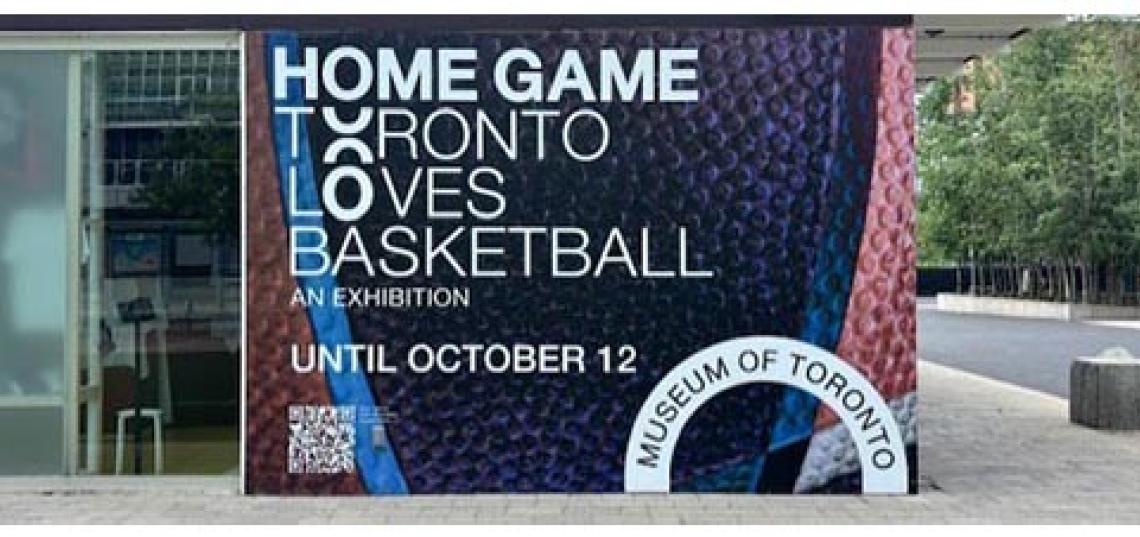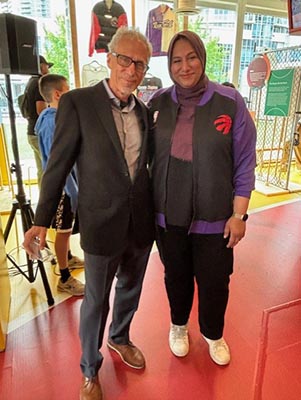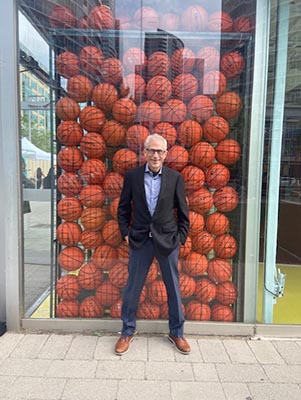
In a city known for its ice hockey obsession, basketball has emerged as another defining part of Toronto’s cultural identity. The exhibit “Home Game: Toronto Loves Basketball,” on view at the Museum of Toronto in Toronto, Canada, traces the increasing popularity of basketball in the city and explores the rich history the city and sport share.
The exhibit was created by Associate Professor of Practice, Library and Information Science Marc Aronson, who said he was inspired to create “Home Game” after the success of an exhibit he co-created in 2020 with SC&I Associate Professor of Communication Jeffrey Lane for the Museum of the City of New York, titled “City/Game: Basketball in New York.”
Creating “City/Game,” Aronson said, was the first time he combined his background in history and his lifelong passion for basketball. The exhibit celebrated and chronicled how the story of basketball in New York City “really tells the immigrant history of New York City.”
 “What I love about streetball is it’s about mixture and meritocracy…if you can play, you can play. And that’s so rare in our society.” He explained that the accessibility of the sport made it easy for anyone to learn, so naturally, New York immigrants took to it and built community through it.
“What I love about streetball is it’s about mixture and meritocracy…if you can play, you can play. And that’s so rare in our society.” He explained that the accessibility of the sport made it easy for anyone to learn, so naturally, New York immigrants took to it and built community through it.
After the success of “City/Game,” Aronson wondered, “...is this true of other cities?” That curiosity eventually led him to Toronto.
“The thing about Toronto is that Canada had extremely restrictive immigration laws. The country was really determined to be a white Protestant Northern European country,” Aronson said. “But in the 1960s, the immigration laws started to slightly open up…and just at that moment, there was an African American man who was a very good athlete and came to Canada during the Vietnam War…and he started to host pickup games at a college there.”
As more immigrant communities grew in Toronto, creating homes for people from Africa, Southeast Asia, and the Caribbean, basketball quickly became a way for them to connect with others and express their individual identities. “People who arrived from warm-weather countries, had never ice skated…but in Toronto they discovered this new sport that favors creativity and individual expression…it’s a kind of dance,” Aronson said. “Basketball started to spread through these new immigrant communities that embraced this new sport.”
As professional basketball grew in Toronto alongside this wave of immigration, the sport led to landmark moments such as the Toronto Raptors’ 2019 NBA Championship win and the upcoming debut of the WNBA team, the Toronto Tempo.
Given this rich history, Aronson said it was no surprise that the city enthusiastically embraced “Home Game.” “The deputy mayor was there,” Aronson recalled, “and four Afro-Canadian boys in their teens just couldn’t wait to come join us. Then this huge line formed for people who wanted to come in and see the exhibit.”
Looking ahead, Aronson said he now wants to expand the exhibits globally. He is now focusing on Paris where immigrants from French-speaking Africa and the Caribbean are mixing with established French people in lively streetball and professional games.
 Aronson also sees opportunities to learn from “Home Game” and replicate its success closer to home for the Rutgers community. “I feel like New Jersey should have a museum exhibit somewhere about New Jersey basketball,” he said, referencing the rich culture of high school, college, and street basketball in the state. As he grew up playing streetball in Manhattan, his children grew up playing at the courts in the suburbs of North Jersey. He’s long dreamed of having researchers on the ground, talking to players and documenting those local stories.
Aronson also sees opportunities to learn from “Home Game” and replicate its success closer to home for the Rutgers community. “I feel like New Jersey should have a museum exhibit somewhere about New Jersey basketball,” he said, referencing the rich culture of high school, college, and street basketball in the state. As he grew up playing streetball in Manhattan, his children grew up playing at the courts in the suburbs of North Jersey. He’s long dreamed of having researchers on the ground, talking to players and documenting those local stories.
Aronson also highlighted the broader impact of public-facing scholarly work. “How do you take the great ideas that we have in the academy…and bring them to a bigger public?” Aronson asked. “One way is through exhibits…another way is through books…another way is through events.”
Ultimately, Aronson hopes “Home Game” encourages audiences to see the deeper connections between the sports and the cities they love. “We want basketball fans to learn the history of their city, and we want people who know the [city’s] history to appreciate basketball,” he said.
The exhibit opened on May 21 and will remain open until October 12, 2025. Admission is free, and more information is available on the Museum of Toronto’s website.
More information about the Communication and Library and Information Science Departments is available on the Rutgers School of Communication and Information website.
Photos courtesy of Marc Aronson. Captions: Aronson with Toronto Deputy Mayor Ausma Malik, the very first hijab-wearing woman to be elected to a public office in Canada. The walls of the Home Game exhibit space are largely made of glass, spreading the excitement of the show to the eyes of all who pass by.
